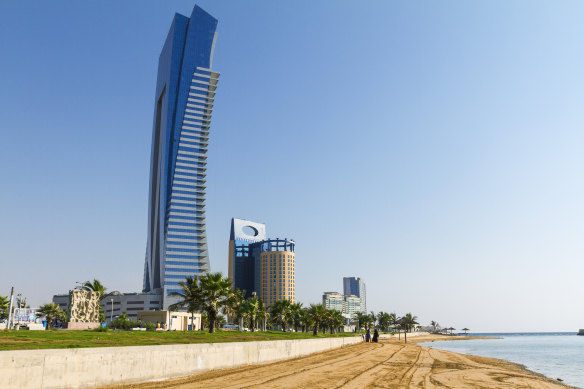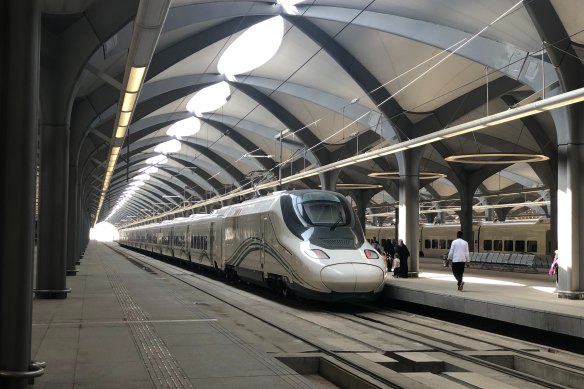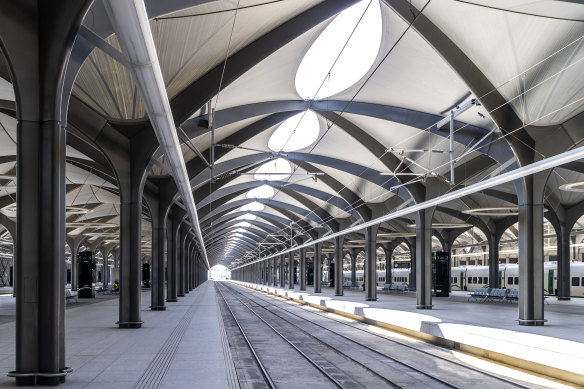Top speed 300km/h: On board the Middle East’s first high-speed train
The train: High speed train from Medina to Jeddah, Saudi Arabia
- The route Medina to Jeddah
- Distance 420km; duration two hours
- Operator Saudi Arabia Railways
- Class Business class
- Frequency Up to 20 times a day
The journey

Jeddah’s Corniche on the Red Sea coast.Credit: iStock
Pilgrims once trekked across the desert to fulfil their religious obligations on this historic route – now, the journey between Islam’s two holiest cities, Medina and Mecca, is best done by bullet train. The Haramain High-Speed Railway line links the two cities via the Red Sea port city of Jeddah, and hits a top speed of 300km/h. I’m travelling the leg from Medina south to Jeddah’s Al-Sulaymaniyah station, and it takes just under two hours to cover 420 kilometres. The Chinese-built line then continues east for another 40 minutes to Mecca – off limits to non-Muslims, although the train is open to all comers. My journey is scheduled to take two hours on the 13-car T350 high-speed train. The trains, by Spanish manufacturer Talgo, are the same as those used by the Spanish government’s Renfe lines, but modified to run in up to 50-degree heat.
The class
Passengers can choose between economy or business class. I’m in business, with a seat facing backwards. Going to Jeddah, the left-hand side has views of farms and atmospheric desert scenery; the right side is pretty grim and industrial. An overhead screen tracks your journey and displays the speed you’re travelling.
Carbon emissions
Ten kilograms a passenger. A direct flight between the two takes one hour, fives minutes and would generate 124 kilograms of carbon.
Boarding

The Haramain high speed train (pictured here at the Mecca station).Credit: Adobe
It’s one of the tenets of Islam that every Muslim – if they can afford it – must make the pilgrimage (Hajj) to Mecca at least once in their lives, so religious tourism is big business in Saudi Arabia. The stations in both Medina and Jeddah are vast, surprisingly glitzy halls with cafes, information kiosks, stores selling Arabian perfumes, snacks and, of course, Saudi’s beloved Al Baik fried chicken. All signs are in Arabic and English, and all staff are fluent in both languages. All passengers and their luggage are run through security screening before boarding.
The seat
The seats throughout are airline-style, with tray tables. In business, the formation is a single on the window and a double on the opposite side, while economy has doubles on either side of the aisle. Each carriage includes two sets of four seats around a table.
Baggage
Each passenger, regardless of class, can bring a handbag and a medium-sized suitcase (35x65x55cm) of up to 25kg, which is stowed overhead or in the baggage racks at the end of each carriage.
Food + drink
My business-class ticket includes a meal served by the cabin attendants from an airline-style trolley. The tray includes a croissant with cheese and what I reckon is a beef Spam, a plain white roll, another roll with cream cheese and chives, a muffin and a bowl of cut fruit. We’re in the Middle East, so there’s also a serve of hummus on the side. I’m offered a choice of juices, coffee or tea by the charming attendants – remember, alcohol is illegal in this kingdom. If you’re still hungry (or possibly coeliac), friendly staff in the buffet car sell snacks and drinks, though the espresso machine is on the blink today. Free, cardamom-infused Arabian coffee is offered to all in short cups, with a couple of individually wrapped dates in a characteristic show of local hospitality.
One more thing…
The train’s name, Haramain, translates as “two sanctuaries”, as it connects Islam’s two holiest mosques, in Medina and Mecca. Most passengers are on a religious pilgrimage, and dressed in the prescribed white robes. I meet pilgrims from as far afield as Ghana and the US. Given the holy nature of most travellers and the destinations, modest dress is appreciated. I wear an abaya – a long robe – over my clothes. As a woman, covering my hair is appreciated, but absolutely not necessary or expected. Expect the train (and every hotel) to be packed out if you’re travelling during the Hajj season.
The verdict

The station in Medina.
Clean, efficient and punctual, the Middle East’s first high-speed train sets a high standard as Saudi’s new train network continues to roll out. Tickets are $95 to $200, depending on class and time of purchase.
Our rating out of five
★★★★
The writer travelled as a guest of the Saudi Tourism Authority. See sar.hhr.sa, visitsaudi.com
Sign up for the Traveller newsletter
The latest travel news, tips and inspiration delivered to your inbox. Sign up now.